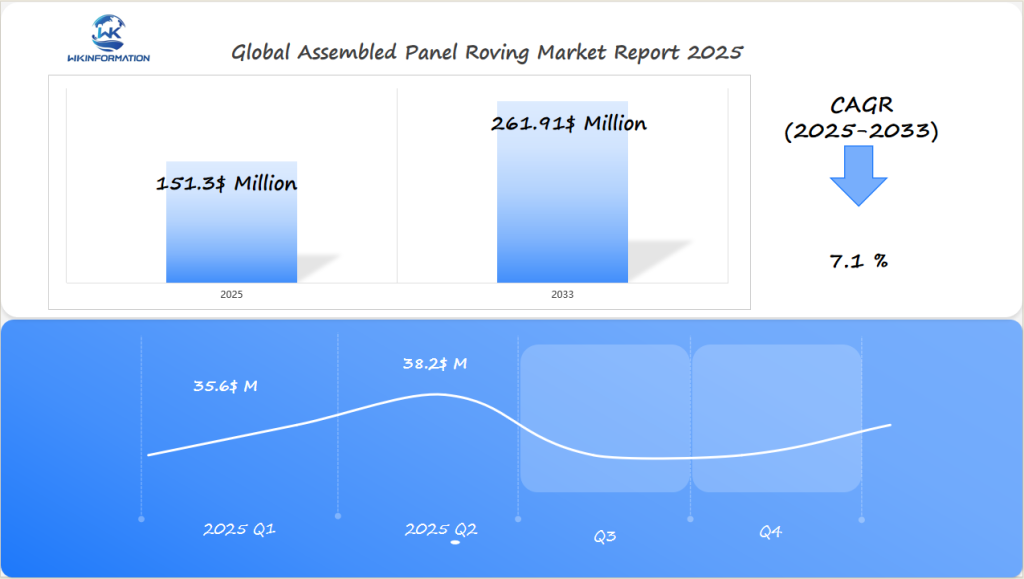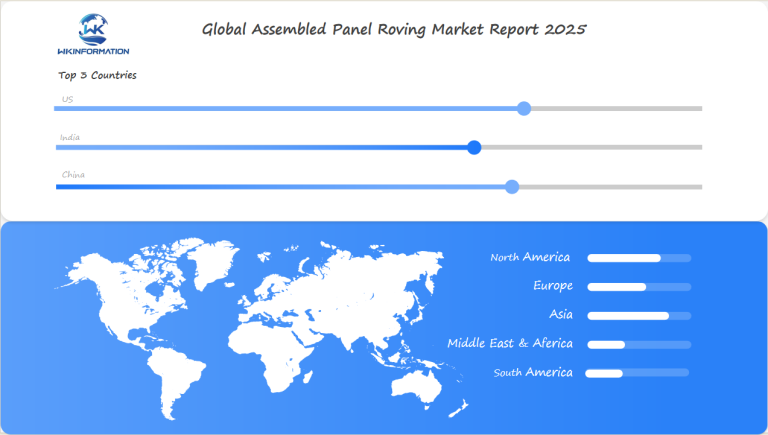2025 Assembled Panel Roving Market Outlook Unlocking $151.3 Million Growth in US, China, and India
Explore the assembled panel roving market’s growth, trends, challenges, and innovations shaping the fiberglass industry by 2025.
- Last Updated:
Assembled Panel Roving Market Outlook for Q1 and Q2 2025
The assembled panel roving market, valued at USD 151.3 million in 2025, is set to grow at a CAGR of 7.1% from 2025 to 2033. Q1 2025 is estimated to see a market size of approximately USD 35.6 million, with Q2 2025 rising to around USD 38.2 million.
The US, China, and India are pivotal in driving market demand, primarily due to the increasing use of composite materials in the construction and automotive sectors. The US is witnessing heightened demand for lightweight and durable materials in aerospace and defense applications. China’s large-scale infrastructure projects and manufacturing capabilities make it a crucial market, while India’s expanding construction sector and investments in sustainable materials further propel industry growth.

Assembled Panel Roving Market Supply Chain and Industry Overview
The supply chain of the assembled panel roving market is crucial to fiberglass production. It includes several stages, from raw material sourcing to manufacturing, distribution, and end-user applications. Key raw materials like silica sand, limestone, and soda ash form the foundation for fiberglass production.
Production Process and Manufacturing Capabilities:
Fiberglass production involves melting raw materials to create molten glass, which is then extruded into fine fibers. These fibers are bundled into roving. As manufacturing technology advances, processes continue to improve in efficiency, producing high-quality fiberglass products.
Applications:
-
Construction: Fiberglass is used in reinforced concrete, facade panels, and insulation materials due to its strength and durability.
-
Automotive: Used in composite panels and reinforced parts, helping reduce vehicle weight and improve fuel efficiency.
-
Marine: Applied in boat hulls and watercraft, providing corrosion resistance and strength.
-
Aerospace: Utilized in aircraft panels and composite structures, offering lightweight strength under extreme conditions.
Market Challenges:
-
Raw Material Price Fluctuations: The cost of raw materials like silica sand and soda ash can impact production costs.
-
Environmental Pressure: The industry faces increasing demand for sustainable practices and recycling solutions.
Key Market Trends Shaping the Future of Assembled Panel Roving in 2025
The assembled panel roving market is experiencing transformative trends, driven by the increasing demand for lightweight materials. As industries such as automotive and aerospace strive for efficiency, fiberglass roving’s lightweight properties make it indispensable.
Sustainability is another pivotal factor shaping this market. A growing focus on environmentally friendly and sustainable materials is pushing manufacturers to innovate. Advanced materials are being developed to reduce environmental impact while maintaining high performance standards.
Renewable energy projects significantly influence market dynamics. Wind energy, in particular, demands larger turbine blades, increasing reliance on fiberglass roving products. This demand underscores the expanding role of renewable energy in driving market growth.
By embracing these trends, the assembled panel roving industry positions itself at the forefront of innovation and sustainability, ensuring its relevance and growth in an ever-evolving global market landscape.
Market Restrictions and Regulatory Challenges in the Assembled Panel Roving Industry
Navigating the regulatory landscape is a critical component of success in the Assembled Panel Roving Market. Various regulations govern the industry, focusing on safety standards, environmental impact, and material specifications. These guidelines are essential to ensure product quality and safety but can also pose significant hurdles for manufacturers.
Challenges Manufacturers Face
Manufacturers often face challenges related to compliance with these regulations:
- Ensuring that all products meet international standards requires substantial investment in testing and certification processes.
- Adapting to varying regulatory requirements across different regions further complicates the compliance landscape.
Impact on Production and Supply Chain
The impact of these regulatory challenges extends to both production and supply chain efficiency:
- Compliance-related delays can lead to increased production costs and affect delivery timelines.
- Failing to meet regulatory standards can result in penalties and damage to brand reputation, impacting market competitiveness.
Understanding and anticipating these challenges enables industry players to develop strategies that mitigate potential disruptions, ensuring consistent growth within this dynamic market.

Geopolitical Influences Affecting the Assembled Panel Roving Market Growth
Geopolitical influences shape the assembled panel roving market by dictating trade policies and international relations. The relationship between major markets like the US, China, and India plays a crucial role in facilitating or hindering growth. Trade tensions can lead to tariffs and barriers, affecting supply chains and pricing dynamics.
- Political stability is another factor; stable governments typically foster an environment conducive to investment and growth, whereas instability can deter investors and disrupt operations.
- Globalization has opened new avenues for expansion, allowing companies to tap into emerging markets. This interconnectedness increases competition but also offers opportunities for collaboration and technological exchange.
In this context, understanding geopolitical landscapes is essential for industry players aiming to navigate challenges and leverage opportunities in the global market.
Assembled Panel Roving Market Segmentation by Type and Key Growth Factors
The assembled panel roving market is segmented based on product type and key growth factors that influence the overall industry dynamics.
-
-
E-glass Roving: The most widely used type in various industries due to its excellent electrical insulation properties and high mechanical strength.
-
S-glass Roving: Known for superior strength and is mainly used in demanding applications, such as aerospace and automotive.
-
Other Specialized Rovings: Includes types with unique properties tailored to specific applications like corrosion resistance or thermal stability.
-
Key Growth Factors:
-
Technological Advancements: Continued innovations in manufacturing processes, such as automated production and the use of advanced extrusion techniques, contribute to the expansion of the market.
-
Increased Demand for Lightweight Materials: The growing emphasis on reducing weight in automotive, aerospace, and construction industries is driving the adoption of fiberglass composites.
-
Sustainability Focus: Increasing environmental regulations and the demand for recyclable materials are prompting manufacturers to invest in eco-friendly fiberglass solutions.
Applications of Assembled Panel Roving and Expanding Market Demand
The applications of assembled panel roving are broad, with increasing demand across various industries:
-
Construction: In reinforced concrete, exterior panels, and insulation products, fiberglass helps achieve durability and thermal efficiency.
-
Automotive: Lightweight composite panels made from fiberglass are increasingly used in vehicles to improve fuel efficiency and reduce emissions.
-
Marine: Its corrosion resistance makes it an ideal material for boat hulls and watercraft structures.
-
Aerospace: Fiberglass’s lightweight properties and high strength are crucial for aircraft panels and composite structures.
As demand for high-performance materials grows, the market for assembled panel roving is expanding, driven by the need for lightweight, durable, and sustainable solutions across these industries.
Global Assembled Panel Roving Market: Regional Insights and Opportunities
The global assembled panel roving market is experiencing significant growth across various regions, with unique opportunities in different markets driven by industry demands and regional preferences.
-
North America (US & Canada):
-
The North American market is primarily driven by the demand for lightweight, durable materials in the automotive, construction, and aerospace sectors.
-
Opportunities are expanding in green building projects and electric vehicles (EVs), which require efficient and sustainable composite materials.
-
-
Europe:
-
Europe has a strong demand for advanced fiberglass products, particularly in automotive and marine sectors. The region also focuses on sustainability, pushing for innovations in recyclable fiberglass solutions.
-
With increasing regulations around carbon emissions, European manufacturers are adopting lighter, stronger materials to improve fuel efficiency.
-
-
Asia-Pacific (China, India, Japan, etc.):
-
The Asia-Pacific region holds substantial growth potential due to rapid industrialization and urbanization, particularly in China and India.
-
The demand for fiberglass is increasing in construction, automotive, and marine sectors, especially for applications requiring high strength-to-weight ratios.
-
-
Middle East & Africa (MEA):
-
The MEA region shows rising demand for fiberglass in construction due to infrastructure development, as well as in oil and gas applications.
-
Growth opportunities also exist in the automotive and aerospace sectors as the region’s manufacturing capabilities expand.
-

US Assembled Panel Roving Market Trends and Competitive Landscape
-
The US market is characterized by a growing demand for lightweight composite materials in sectors such as automotive, construction, and aerospace.
-
There is a trend towards sustainability and the adoption of green building materials, further pushing the demand for fiberglass products.
-
The market is highly competitive with key players investing in technological advancements, such as automation in fiberglass production and advanced extrusion techniques.
-
Additionally, the rise of electric vehicles (EVs) is creating new opportunities for using lightweight materials like fiberglass in the automotive industry.
China Assembled Panel Roving Market Demand and Industry Strategies
-
China remains a dominant player in the global fiberglass market, driven by robust growth in the construction, automotive, and marine sectors.
-
China’s demand for assembled panel roving is supported by rapid urbanization, large infrastructure projects, and the government’s focus on environmentally friendly materials.
-
Local manufacturers are adopting strategies such as vertical integration and improving manufacturing capabilities to cater to both domestic and international markets.
-
With a growing emphasis on sustainability, China is exploring recyclable fiberglass solutions and aiming to reduce the environmental footprint of its production processes.
India Assembled Panel Roving Market Expansion and Market Forecast
-
The Indian market is experiencing steady growth, driven by increased demand in construction, automotive, and aerospace industries.
-
India’s expanding infrastructure projects, coupled with a focus on green buildings and lightweight vehicles, are expected to fuel the demand for fiberglass composites in the coming years.
-
Key factors driving the market include government initiatives for infrastructure development, automotive sector growth, and rising awareness of the benefits of lightweight materials in reducing energy consumption.
-
The market is forecasted to see strong expansion due to increasing industrialization and growing foreign investments in India’s manufacturing sector, especially in electric vehicle production.
Future Innovations and Technological Developments in Assembled Panel Roving
Emerging technologies are reshaping the Assembled Panel Roving Market, elevating production efficiency to new heights. These advancements are driven by innovations such as automated manufacturing processes and real-time monitoring systems, which streamline operations and reduce waste.
1. Automated Manufacturing
Robotics and AI integration allow for precise control over production lines, minimizing human error and enhancing output quality.
2. Real-Time Monitoring Systems
Implementing IoT devices within manufacturing facilities enables continuous data collection, leading to proactive maintenance and reduced downtime.
Innovations aimed at enhancing product offerings are equally transformative. The development of high-performance fibers with improved tensile strength and thermal resistance is expanding the application range of assembled panel roving.
- High-Performance Fibers: Enhanced durability and adaptability meet the growing demands of industries like aerospace and construction, offering tailored solutions for specific needs.
These technological advancements not only bolster market growth but also position key players to capitalize on emerging opportunities.
Competitive Landscape and Key Players in the Assembled Panel Roving Market
The assembled panel roving market is highly competitive, with several leading companies playing a significant role in its growth.
Key Players:
- Taishan Fiberglass – China
- Changzhou Tianma Group – China
- Owens Corning – USA
- Basaltex – Belgium
- Basalt Fiber – Russia
- Johns-Manville – USA
- Anuj Fiber – India
- Beihai Fiberglass – China
- Nittobo – Japan
- Hitex Composites – India
Strategies for Growth
These companies employ several strategies to stay ahead in the industry:
- Innovation: Developing new product lines to meet evolving market requirements.
- Expansion: Establishing manufacturing facilities in emerging markets, which aligns with the trends observed in the broader Asia-Pacific glass fabric market.
- Sustainability Initiatives: Incorporating eco-friendly practices to align with global environmental goals.
This dynamic landscape presents opportunities for growth as companies adapt to changing industry trends and customer preferences.
Overall
| Report Metric | Details |
|---|---|
| Report Name | Global Assembled Panel Roving Market Report |
| Base Year | 2024 |
| Segment by Type |
· E-glass Roving · S-glass Roving · Others |
| Segment by Application |
· Construction · Automotive · Aerospace · Marine · Others |
| Geographies Covered |
· North America (United States, Canada) · Europe (Germany, France, UK, Italy, Russia) · Asia-Pacific (China, Japan, South Korea, Taiwan) · Southeast Asia (India) · Latin America (Mexico, Brazil) |
| Forecast units | USD million in value |
| Report coverage | Revenue and volume forecast, company share, competitive landscape, growth factors and trends |
The assembled panel roving market is set for promising growth, with projections indicating it could reach $151.3 million by 2025. This growth is driven by the increasing demand for lightweight and sustainable materials in industries such as automotive, aerospace, and renewable energy.
Key players in the market are actively working on innovations and forming strategic partnerships to strengthen their position. This dynamic environment suggests that the industry is well-prepared to take advantage of new opportunities.
For those who want to understand the market better, there are detailed reports available that provide in-depth insights and forecasts. These resources will help stakeholders navigate the changing landscape of the assembled panel roving market effectively.
Global Assembled Panel Roving Market Report (Can Read by Free sample) – Table of Contents
Chapter 1: Assembled Panel Roving Market Analysis Overview
- Competitive Forces Analysis (Porter’s Five Forces)
- Strategic Growth Assessment (Ansoff Matrix)
- Industry Value Chain Insights
- Regional Trends and Key Market Drivers
- Assembled Panel Roving Market Segmentation Overview
Chapter 2: Competitive Landscape
- Global Assembled Panel Rovingplayers and Regional Insights
- Key Players and Market Share Analysis
- Sales Trends of Leading Companies
- Year-on-Year Performance Insights
- Competitive Strategies and Market Positioning
- Key Differentiators and Strategic Moves
Chapter 3: Assembled Panel Roving Market Segmentation Analysis
- Key Data and Visual Insights
- Trends, Growth Rates, and Drivers
- Segment Dynamics and Insights
- Detailed Market Analysis by Segment
Chapter 4: Regional Market Performance
- Consumer Trends by Region
- Historical Data and Growth Forecasts
- Regional Growth Factors
- Economic, Demographic, and Technological Impacts
- Challenges and Opportunities in Key Regions
- Regional Trends and Market Shifts
- Key Cities and High-Demand Areas
Chapter 5: Assembled Panel Roving Emerging and Untapped Markets
- Growth Potential in Secondary Regions
- Trends, Challenges, and Opportunities
Chapter 6: Product and Application Segmentation
- Product Types and Innovation Trends
- Application-Based Market Insights
Chapter 7: Assembled Panel Roving Consumer Insights
- Demographics and Buying Behaviors
- Target Audience Profiles
Chapter 8: Key Findings and Recommendations
- Summary of Assembled Panel Roving Market Insights
- Actionable Recommendations for Stakeholders

Access the study in MULTIPLEFORMATS
Didn’t find what you’re looking for?
TALK TO OUR ANALYST TEAM
Need something within your budget?
NO WORRIES! WE GOT YOU COVERED!
Call us on: +1-866-739-3133
Email: infor@wkinformation.com
What is the projected growth of the Assembled Panel Roving market?
The Assembled Panel Roving market is projected to reach a significant value of $151.3 million, highlighting its importance within the fiberglass industry.
What are the key trends shaping the future of the Assembled Panel Roving market in 2025?
Key trends include an increasing demand for lightweight materials, a focus on sustainability, and the impact of renewable energy projects on market dynamics.
What regulatory challenges do manufacturers face in the Assembled Panel Roving industry?
Manufacturers encounter various compliance challenges due to regulations affecting production processes and supply chains, which can impact overall market operations.
How do geopolitical influences affect the growth of the Assembled Panel Roving market?
Geopolitical factors such as trade relations between major markets like the US, China, and India, as well as political stability, significantly influence market growth and dynamics.
Which regions are identified as high-growth areas for the Assembled Panel Roving market?
Emerging markets like India present substantial opportunities for expansion, alongside a comprehensive overview of global market distribution indicating high-growth regions.
What innovations are currently shaping the Assembled Panel Roving market?
Emerging technologies are enhancing production efficiency while innovations aim to improve product offerings within the Assembled Panel Roving sector.

